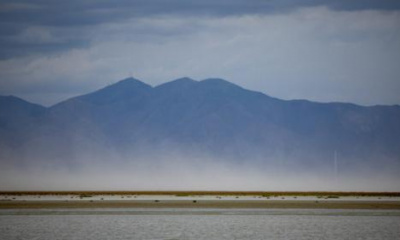SALT LAKE CITY — In the days after arriving at what's now the Salt Lake Valley, Brigham Young and handful of other leaders from The Church of Jesus Christ of Latter-day Saints ventured toward the Great Salt Lake.
They bathed in the lake's water, near a rock that would later be used to help measure the lake's water levels, before returning back to Salt Lake City.
But the Great Salt Lake isn't as great as it used to be.
Lake levels hit an all-time low last year (4,190.2 feet), breaking records that date back to the same year the pioneers arrived, in 1847. State natural resource officials say it's possible, if not likely, that lake levels will get even lower this year because not all of the current snowpack will reach its natural destination.
The Great Salt Lake doesn't provide drinking water but its health is still vital to Utah residents and for the millions of creatures that live or travel past it. It's why state lawmakers unanimously passed a bill last week to provide $40 million toward watershed enhancements at the lake.
The lake's importance is also why over a dozen Utah news, education and media organizations — sometimes competing organizations — are coming together for the first time as the Great Salt Lake Collaborative. The collaborative will provide coverage that addresses the current state of the lake and the possible solutions that may save it before it's too late.
The collaborative is funded through a grant from the Knight Foundation via the Solutions Journalism Network's Local Media Project.
Why the Great Salt Lake is important
Not only did the Great Salt Lake hit an all-time low last year, but its levels are also about half of its historic average. The Utah Department of Natural Resources reported last month that levels have risen since hitting an all-time low in October, but the rise will likely end when the irrigation season begins this spring.
That's when a chunk of the water from the lake's tributaries gets divided up by property owners who have water rights. The department says inflow is needed for the lake to overcome its typical summer drop of about 2.3 feet.
The Great Salt Lake is important for many reasons. As noted by the Deseret News, a study released a decade ago found the Great Salt Lake has an economic value of $1.32 billion, including a $67 million brine shrimp industry.
A healthy lake has the potential to increase snowpack levels in northern Utah through lake effect snow. A dry lake exposes dust that can be blown into nearby communities, causing air quality issues, also harming mountain snowpacks, as research from the University of Utah indicates. Snowpack runoff accounts for about 95% of the state's water supply.
It's estimated that over 10 million birds from 338 species use the Great Salt Lake every year, according to the Utah Division of Wildlife Resources. That includes one of the largest pelican rookeries at Gunnison Island within the Great Salt Lake.
These are just a few of the examples of why the Great Salt Lake is important to Utah.
A collaborative information effort
The goal of the Great Salt Lake Collaborative effort is to provide information about the issues at the Great Salt Lake and what can be done to solve them.
The collaboration will feature articles and other media, including photographs, that highlight the current situation, what can be done to help the ailing lake and the challenges of getting water back to it.
Some of the coverage can be found at KSL.com; however, complete coverage of the Great Salt Lake can be found throughout the rest of the collaborative team, too, which includes:
- Amplify Utah
- Deseret News
- Fox 13
- The Great Salt Lake Institute at Westminster College
- KCPW
- KRCL
- KSL.com
- KSL-TV
- KSL NewsRadio
- KUER
- Salt Lake City Public Library
- Salt Lake Community College Community Writing Center
- Salt Lake Tribune
- Standard-Examiner
- The West View
- Utah Film Center
- Utah Public Radio
- Utah State University (independent researcher)
If you have ideas or want to share your experiences with the lake, you can also participate through this survey.








